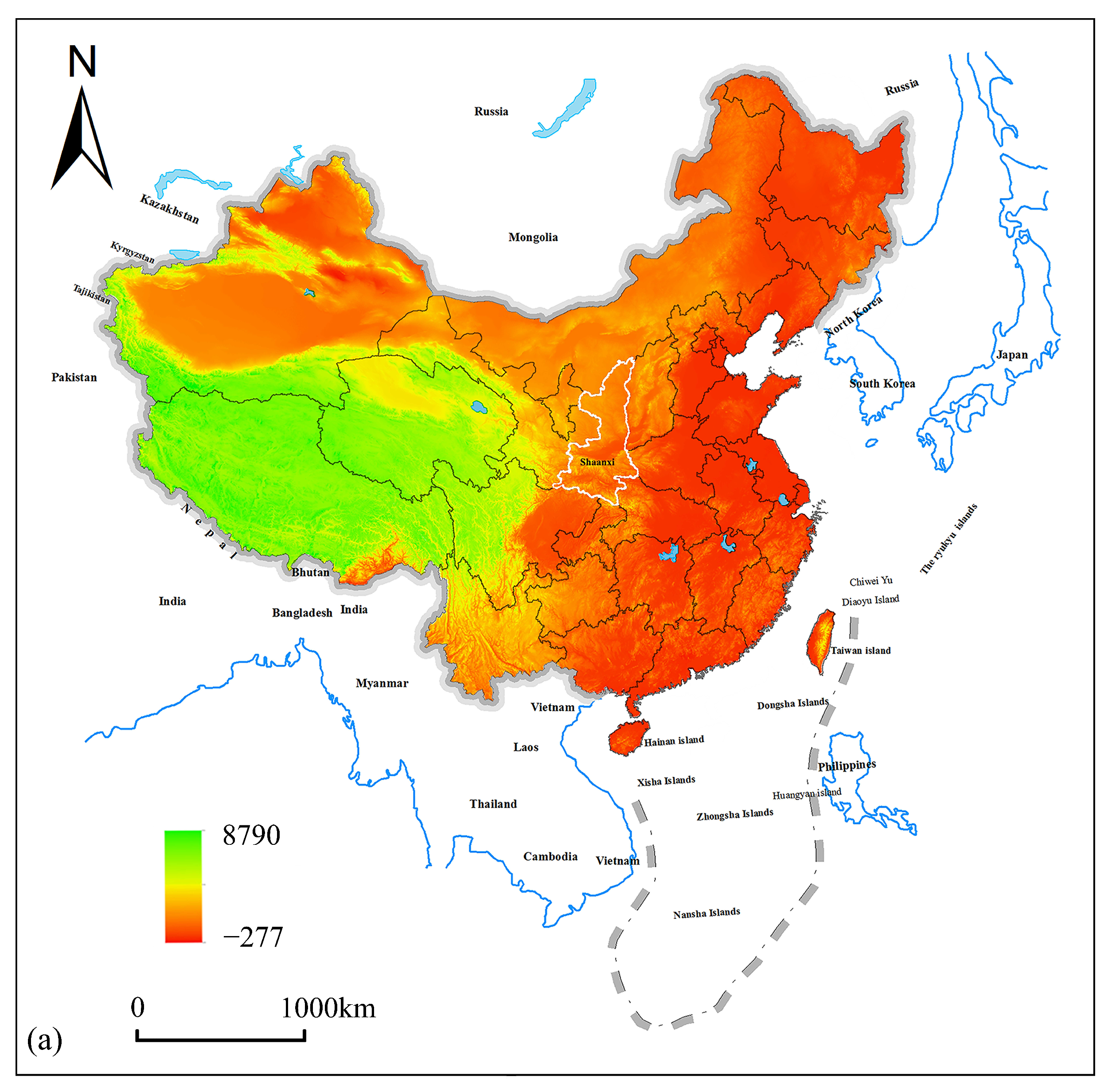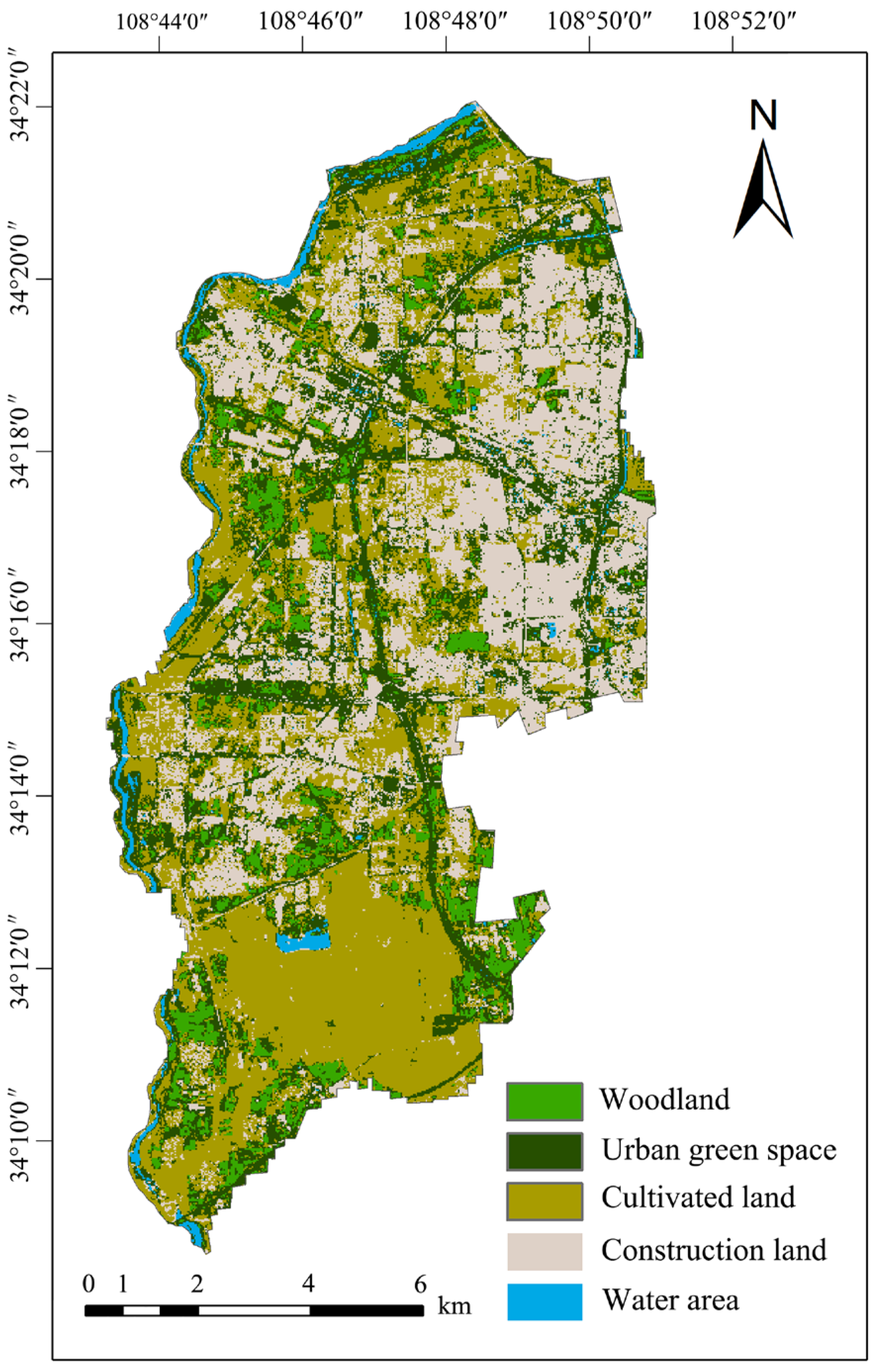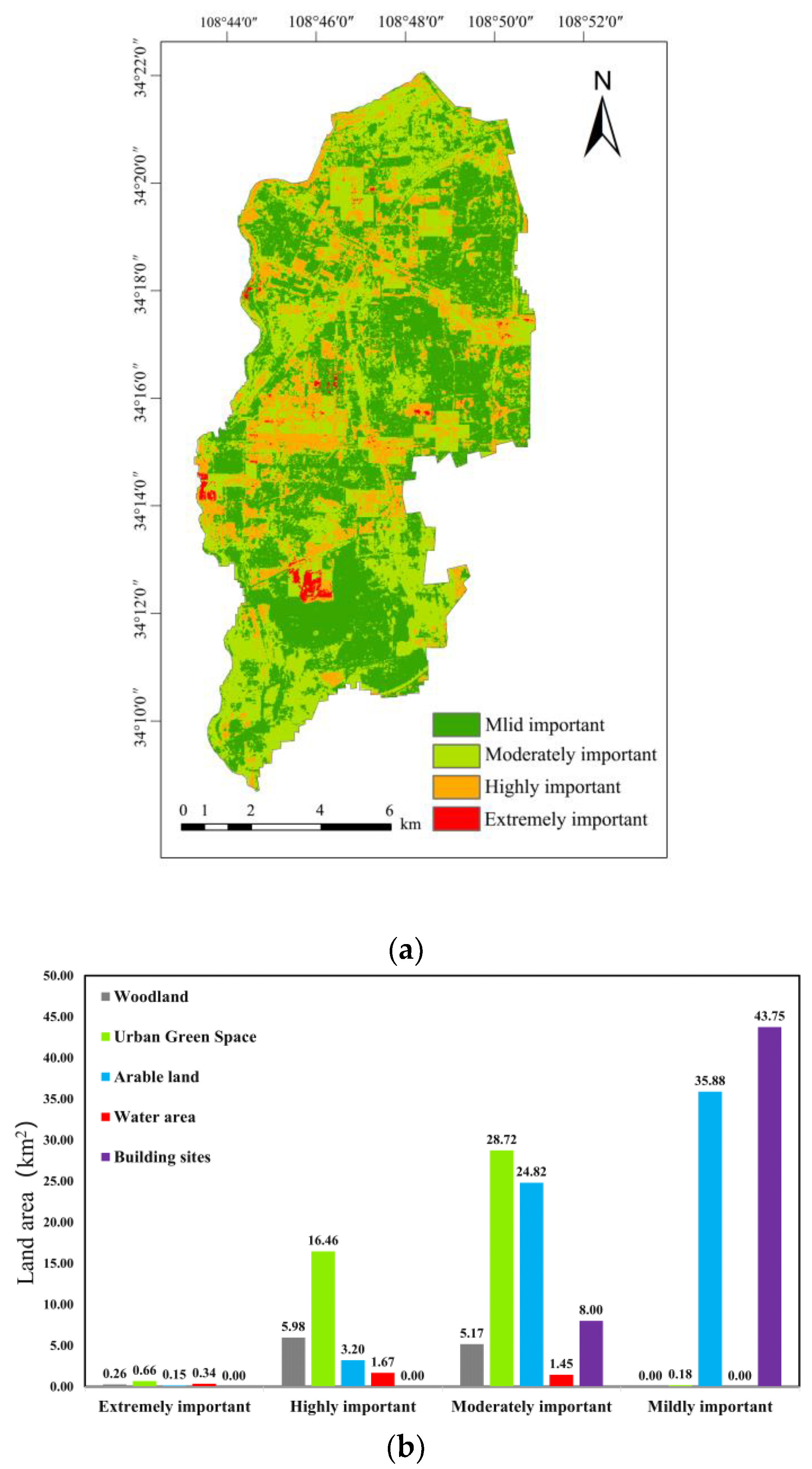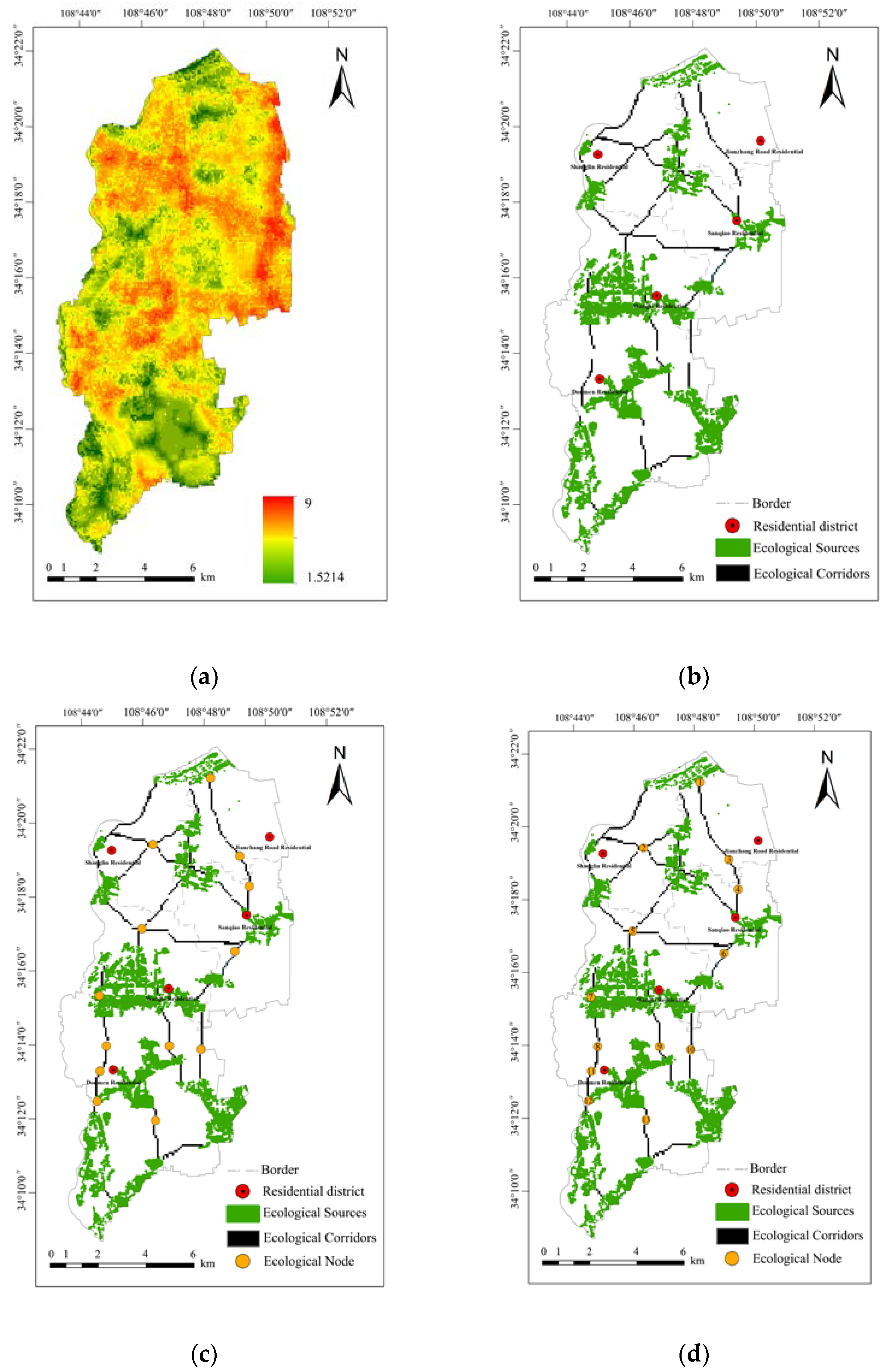Urban Green Space Planning Based on Remote Sensing and Geographic Information Systems
Abstract
:1. Introduction
2. Study Area and Data Sources
2.1. Overview of the Study Area
2.2. Data Source
3. Materials and Methods
3.1. Research Technology Route
3.2. Evaluating the Importance of Ecological Land in Urban Green Space
3.2.1. Calculating Ecosystem Functions
3.2.2. Calculating Ecological Demand Intensity
3.2.3. Constructing the Indicator System
3.3. Extracting Ecological Corridor Data per the Minimum Cumulative Resistance Model
3.3.1. Determining the Resistance Factor and Values
3.3.2. Minimum Cumulative Resistance Model
3.4. Determination of the Weight of the Evaluation Systems
4. Results
4.1. Ecological Sources
4.1.1. Distributing Ecological Land Importance under the Influence of Ecosystem Functions
4.1.2. Distributing Ecological Land Importance under Ecological Demand Intensity
4.1.3. Evaluating the Importance of Ecological Land under Comprehensive Consideration
4.1.4. Identification of Ecological Sources
4.2. Ecological Corridors and Nodes
4.2.1. Determination of Resistance Surfaces
4.2.2. Identification of Ecological Corridors
4.2.3. Identifying Ecological Nodes
4.3. Constructing Green Spaces
5. Discussion
6. Conclusions
Author Contributions
Funding
Data Availability Statement
Acknowledgments
Conflicts of Interest
References
- Li, Y. Thinking of developing urban planning theory. Urban Plan. 2005, 5, 34–38. [Google Scholar]
- Shahtahmassebi, A.R.; Li, C.; Fan, Y.; Wu, Y.; Gan, M.; Wang, K.; Malik, A.; Blackburn, G.A. Remote sensing of urban green spaces: A review. Urban For. Urban Green. 2021, 57, 126946. [Google Scholar] [CrossRef]
- Shafique, M.; Xiaowei, L.; Jian, Z. Photovoltaic-green roofs: A review of benefits, limitations, and trends. J. Sol. Energy 2020, 202, 485–497. [Google Scholar] [CrossRef]
- Puttinaovarat, S.; Horkaew, P.A. Geospatial platform for crowdsourcing green space area management using GIS and deep learning classification. ISPRS Int. J. Geo-Inf. 2022, 11, 208. [Google Scholar] [CrossRef]
- Shafique, M.; Reeho, K. Recent progress in low-impact development in South Korea: Water-management policies, challenges and opportunities. Water 2018, 10, 435. [Google Scholar] [CrossRef]
- Luo, P.P.; Mu, Y.; Wang, S.T.; Zhu, W.; Binaya, K.M.; Huo, A.D.; Zhou, M.M.; Lyu, J.Q.; Hu, M.C.; Duan, W.L.; et al. Exploring sustainable solutions for the water environment in Chinese and Southeast Asian cities. Ambio 2021, 51, 1199–1218. [Google Scholar] [CrossRef]
- Narain, V. Taken for a ride? Mainstreaming periurban transport with urban expansion policies. Land Use Policy 2017, 64, 145–152. [Google Scholar] [CrossRef]
- Riechers, M.; Barkmann, J.; Tscharntke, T. Diverging perceptions by social groups on cultural ecosystem services provided by urban green. Landsc. Urban Plan. 2018, 175, 161–168. [Google Scholar] [CrossRef]
- Wei, X.D.; Wang, N.; Luo, P.P.; Yang, J.; Zhang, J.; Lin, K. Spatiotemporal assessment of land marketization and its driving forces for sustainable urban–rural development in Shaanxi Province in China. Sustainability 2021, 13, 7755. [Google Scholar] [CrossRef]
- Zha, X.B.; Luo, P.P.; Zhu, W.; Wang, S.T.; Lyu, J.Q.; Zhou, M.M.; Huo, A.H.; Wang, Z.H. A bibliometric analysis of the research on Sponge City: Current situation and future development direction. Ecohydrology 2021, 14, e2328. [Google Scholar] [CrossRef]
- Regional Plan Association. Shaping the Region; Regional Plan Association: New York, NY, USA, 2015. [Google Scholar]
- Turner, T. Open space planning in London: From standards per 1000 to green strategy. Town Plan. Rev. 1992, 63, 365. [Google Scholar] [CrossRef]
- Tang, Y. Central Park New York City USA. Chin. Landsc. Archit. 1994, 4, 38–41. [Google Scholar]
- Bullock, C.H. Valuing urban green space: Hypothetical alternatives and the status quo. J. Environ. Plan. Manag. 2008, 51, 15–35. [Google Scholar] [CrossRef]
- Thompson, C.W. Urban open space in the 21st century. Landsc. Urban Plan. 2002, 60, 59–72. [Google Scholar] [CrossRef]
- Mensah, C.A. Urban green spaces in Africa: Nature and challenges. Int. J. Ecosyst. 2014, 4, 1–11. [Google Scholar]
- Peschardt, K.K.; Schipperijn, J.; Stigsdotter, U.K. Use of small public urban green spaces (SPUGS). Urban For. Urban Green. 2012, 11, 235–244. [Google Scholar] [CrossRef]
- James, P.; Tzoulas, K.; Adams, M.D.; Barber, A.; Box, J.; Breuste, J.; Elmqvist, T.; Frith, M.; Gordon, C.; Greening, K.L.; et al. Towards an integrated understanding of green space in the European built environment. Urban For. Urban Green. 2009, 8, 65–75. [Google Scholar] [CrossRef]
- Heidt, V.; Neef, M. Benefits of Urban Green Space for Improving Urban Climate. In Ecology, Planning, and Management of Urban Forests; Carreiro, M.M., Song, Y.C., Wu, J., Eds.; Springer: New York, NY, USA, 2008; pp. 84–96. [Google Scholar]
- Benedict, M.A.; McMahon, E.T. Green Infrastructure: Linking Landscapes and Communities; Island Press: Washington, DC, USA, 2012. [Google Scholar]
- Lwin, K.K.; Murayama, Y. Modelling of urban green space walk ability: Eco-friendly walk score calculator. Comput. Environ. Urban Syst. 2011, 35, 408–420. [Google Scholar] [CrossRef]
- President’s Council on Sustainable Development. Toward A Sustainable America: Advancing Prosperity, Opportunity and A Healthy Environment for the 21st Century; Diane Publishing: Collingdale, PA, USA, 1999.
- Evert, K.J. Dictionary Landscape and Urban Planning; Springer: Berlin, Germany, 2001. [Google Scholar]
- Kabisch, N.; Haase, D. Green spaces of European cities revisited for 1990–2006. Landsc. Urban Plan. 2013, 110, 113–122. [Google Scholar] [CrossRef]
- Xiaoxiang, S. A study on park and green space system with special reference to urban environmental protection. Acta Hortic. Sin. 1980, 4, 49–54. [Google Scholar]
- Zhang, W. People and green space. Environ. Prot. 1981, 2, 24–26. [Google Scholar]
- Li, M. From rural city to landscape gardening: The development of green space planning of human settlement environment. Archit. J. 1995, 10, 10–14. [Google Scholar]
- Shen, D.X.; Xiong, G.P. On urban green open space. Urban Plan. 1996, 6, 7–11. [Google Scholar]
- Li, F.; Wang, R. Research advance in ecosystem service of urban green space. J. Appl. Ecol. 2004, 15, 527–531. [Google Scholar]
- Lin, Y.E.; Zhong, X.I.; Wentao, Y.A. Reflections on urban green space planning in mountain city. J. Hum. Settl. West China 2014, 29, 37–44. [Google Scholar]
- Huang, T.-T.; Gao, M.-Y.; Han, R.-D.; Zhu, J.-N. Urban green space system planning under the background of land and space. J. Chin. Urban For. 2020, 18, 54–59. [Google Scholar]
- Toledo-Pereyra, L.H. Raul Romero-Torres: Surgeon, teacher, and pioneer (1928–2005). J. Investig. Surg. 2006, 19, 331. [Google Scholar] [CrossRef]
- Apan, A.A.; Raine, S.R.; Paterson, M.S. Mapping and analysis of changes in the riparian landscape structure of the Lockyer Valley catchment, Queensland, Australia. Landsc. Urban Plan. 2002, 59, 43–57. [Google Scholar] [CrossRef]
- Tomlinson, R. Thinking about GIS; Esri Press: California, CA, USA, 2007; p. 6. [Google Scholar]
- Wolf, W.J. Maryland’s green infrastructure—Using landscape assessment tools to identify a regional conservation strategy. Environ. Monit. Assess. 2000, 63, 265–277. [Google Scholar]
- Barton, C.M.; Bernabeu, J.; Aura, J.E.; Garcia, O.; La Roca, N. Dynamic landscapes, artifact taphonomy, and land use modeling in the Western Mediterranean. Geoarchaeol. Int. J. 2010, 17, 155–190. [Google Scholar] [CrossRef]
- Bunn, A.G.; Urban, D.L.; Keitt, T.H. Landscape connectivity: A conservation application of graph theory. J. Environ. Manag. 2000, 59, 265–278. [Google Scholar] [CrossRef] [Green Version]
- Wang, X.X.; Peng, L.; Su, C.J.; Xu, D.D.; Chen, T.T. Development and utilization of low-slope hilly land resources based on a landscape security pattern theory: A case study in Luxian County, Sichuan Province. Acta Ecol. Sin. 2016, 36, 3646–3654. [Google Scholar]
- Wang, M.Y.; Li, J.L.; Zheng, Z.N.; Jiang, W.D.; Xu, L.H.; Yang, L.; Yuan, Q.X.; Lu, X.Z.; Xiao, W. Landscape pattern optimization based on intensity of ecological function of mud flat reclamation: A case study of Dongtai County of Jiangsu Province. Chin. J. Ecol. 2015, 34, 1943–1949. [Google Scholar]
- Li, H.; Yi, N.; Yao, W.J.; Wang, S.Q.; Li, Z.Y.; Yang, S.H. Shangri-La county ecological land use planning based on landscape security pattern. Acta Ecol. Sin. 2011, 31, 5928–5936. [Google Scholar]
- Li, J.F.; Li, L.; Guo, L.; Du, S.H. Assessment on the ecological suitability in Zhuhai City, Guangdong, China, based on minimum cumulative resistance model. Chin. J. Appl. Ecol. 2016, 27, 225–232. [Google Scholar]
- Yang, T.R.; Kuang, W.H.; Liu, W.D.; Liu, A.L.; Pan, T. Optimizing the layout of eco-spatial structure in Guanzhong urban agglomeration based on the ecological security pattern. Geogr. Res. 2017, 36, 441–452. [Google Scholar]
- Liu, X.F.; Shu, J.M.; Zhang, L.B. Research on applying minimal cumulative resistance model in urban land ecological suitability assessment: As an example of Xiamen City. Acta Ecol. Sin. 2010, 30, 421–428. [Google Scholar]
- Shao, M.; Li, F.Z.; Li, X. Evaluation of supply and demand of green space ecosystem service function in Chengdu-Chongqing Urban agglomeration based on multi-source data. Landsc. Archit. 2021, 28, 60–66. [Google Scholar]
- Mu, D.; Luo, P.P.; Lyu, J.; Zhou, M.; Huo, A.; Duan, W.; Nover, D.; He, B.; Zhao, X. Impact of temporal rainfall patterns on flash floods in Hue City, Vietnam. J. Flood Risk Manag. 2020, 14, e12668. [Google Scholar] [CrossRef]
- Peng, J.; Li, H.L.; Liu, Y.X.; Hu, Y.N.; Yang, Y. Identification and optimization of ecological security pattern in Xiong’an New Area. Acta Geogr. Sin. 2018, 73, 701–710. [Google Scholar]
- Wang, Y.Y.; Jin, X.B.; Shen, C.Z.; Bao, G.Y.; Liu, J.; Zhou, Y.K. Establishment of an ecological security pattern in the eastern developed regions: A case study of the Sunan District. Acta Ecol. Sin. 2019, 39, 2298–2310. [Google Scholar]
- Zhu, J.; Su, J.; Yin, H.W.; Kong, F.H. Construction of Xuzhou ecological network based on comprehensive sources identification and multi-scale nesting. J. Nat. Resour. 2020, 35, 1986–2001. [Google Scholar]
- Wu, M.Q.; Hu, M.M.; Wang, T.; Fan, C.; Xia, B.C. Recognition of urban ecological source area based on ecological security pattern and multi-scale landscape connectivity. Acta Ecol. Sin. 2019, 39, 4720–4731. [Google Scholar]
- Zhang, Y.N.; Chen, Z.-J.; Zhang, Y.-Q.; Mei, M. Urban ecological importance assessment based on ecological function and ecological demand: A case study of Changsha resources and environment in the Yangtze Basin. Resour. Environ. 2018, 27, 2358–2367. [Google Scholar]
- Liu, S.H. On the demand of ecological economy. Econ. Res. J. 1988, 4, 77–79. [Google Scholar]
- Rumelhart, D.E.; Hinton, G.E.; Williams, R.J. Learning representations by back-propagating errors. Nature 1986, 323, 533–536. [Google Scholar] [CrossRef]
- Li, M.Y.; Tian, F.H.; Dong, Y.Z. Space identification of ecological importance and protection on urban ecological land in Yanji-Longjing-Tumen Area. Sci. Geol. Sin. 2016, 36, 1870–1876. [Google Scholar]
- Deng, X.; Li, J.; Zeng, H.; Chen, J.; Zhao, J. Research on computation methods of AHP wight vector and its applications. Math. Pract. 2012, 42, 93–100. [Google Scholar]
- Xu, K.; Kong, C.; Li, J.; Zhang, L. GEO-Environmental Suitability Evaluation of Land for Urban Construction Based on a Back-Propagation Neural Network and GIS: A Case Study of Hangzhou. J. Phys. Geogr. 2012, 33, 457–472. [Google Scholar] [CrossRef]
- Sun, H.; Zhao, J.; Pan, B.; Xiao, L. Assessment of suitability of construction land based on GIS and BPNN. Sci. Technol. Manage. Land Resour. 2008, 6, 112–116. [Google Scholar]
- Thenkabail, P.S. Remote Sensing Handbook; CRC Press: Boca Raton, FL, USA, 2015. [Google Scholar]
- Xie, G.D.; Lu, C.Z.; Xiao, Y.; Zheng, D. The economic evaluation of grassland ecosystem services in Qingha-iTibet Plateau. J. Mt. Sci. 2003, 21, 50–55. [Google Scholar]
- Qin, Y.L.; Shi, P.; He, W.H.; Huo, C.P.; Li, P.; Li, Z.B.; Yang, S.T.; Feng, Z.H. Influence of urbanization on landscape pattern and ecosystem service value in Xi’an City. Acta Ecol. Sin. 2020, 40, 8239–8250. [Google Scholar]
- Meng, X.; Cao, G.; Wenhui, A.N.; Zhixia, Y.U. Study on ecosystem services of Xixian new area based on land use planning. Ecol. Sci. 2017, 36, 142–148. [Google Scholar]
- Wang, J.J.; Gong, B. Evolution of landscape pattern and ecological risk in Xixian new area. J. Northeast For. Univ. 2019, 34, 250–256. [Google Scholar]
- Meng, J.-J.; Wang, Y.; Wang, X.D.; Zhou, Z.; Sun, N. Construction of landscape ecological security pattern in GUIYANG based on MCR model. Resour. Environ. Yangtze Basin 2016, 25, 1052–1061. [Google Scholar]
- Lü, Y.H.; Hu, J.; Sun, F.X.; Zhang, L.W. Water retention and hydrological regulation: Harmony but not the same in terrestrial hydrological ecosystem services. Acta Ecol. Sin. 2015, 35, 5191–5196. [Google Scholar]
- Zhu, Y.; Luo, P.; Su, F.; Zhang, S.; Sun, B. Spatiotemporal analysis of hydrological variations and their impacts on vegetation in semiarid areas from multiple satellite data. Remote Sens. 2020, 12, 4177. [Google Scholar] [CrossRef]
- Liu, G.F.; Wu, B.; Fan, W.Y.; Li, X.S.; Fan, N.N. Extraction of vegetation coverage in desertification regions based on the dimidiate pixel model—a case study in Maowusu Sandland. Res. Soil Water Conserv. 2007, 14, 268–271. [Google Scholar]
- Liu, B.Y.; Guo, S.Y.; Li, Z.G.; Xie, Y.; Zhang, L.L.; Liu, X.C. Sampling survey of hydraulic erosion in China. J. Chin. Soil Water Conserv. 2013, 10, 26–34. [Google Scholar]
- He, C.Y.; Shi, P.J.; Li, J.G.; Chen, J.; Pan, Y.; Li, J.; Zhuo, L.; Ichinose, T. Restoring urbanization process in China in the 1990s by using non-radiance-calibrated DMSP/OLS nighttime light imagery and statistical data. Chin. Sci. Bull. 2006, 51, 1614–1620. [Google Scholar] [CrossRef]
- Wang, Y.; Zhang, S.M.; Zhang, Y.; Zheng, L.L.; Zhao, X.Y.; Tao, Y.L.; Tian, G.H. Spatiotemporal responses of the fragmentation of green space to the human activity intensity in Zhengzhou City. J. Northeast For. Univ. 2021, 36, 231–239. [Google Scholar]
- Lu, D.; Tian, H.; Zhou, G.; Ge, H. Regional mapping of human settlements in Southeastern China with multisensor remotely sensed data. Remote Sens. Environ. 2008, 112, 3668–3679. [Google Scholar] [CrossRef]
- Huang, M.Y.; Yue, W.Z.; Feng, S.R.; Cai, J.J. Analysis of spatial heterogeneity of ecological security based on MCR model and ecological pattern optimization in the Yuexi county of the Dabie Mountain Area. J. Nat. Resour. 2019, 34, 771–784. [Google Scholar] [CrossRef]
- Knaapen, J.P.; Scheffer, M.; Harms, B. Estimating habitat isolation in landscape planning. Landsc. Urban Plan. 1992, 23, 1–16. [Google Scholar] [CrossRef]
- Gao, J. Principle and Simulation Example of Artificial Neural Network; China Machine Press: Beijing, China, 2003; p. 7. [Google Scholar]
- Xia, K.; Li, C.-B.; Shen, J.-Y. An optimization algorithm on the number of hidden layer nodes in feed-forward neural network. Comput. Sci. 2005, 32, 143–145. [Google Scholar]
- Sun, H.J.; Wang, X.H. Determination of the weight of evaluation indexes with artificial neural network method. J. Shandong Univ. Sci. Technol. Nat. Sci. 2001, 20, 84–86. [Google Scholar]
- Wang, L.H.; Zhang, D.Q.; Li, K.J. A survey of river ecosystem services value evaluation. Chin. J. Popul. Resour. Environ. 2015, 25, 10–14. [Google Scholar]
- Huang, W.; Weili, D.; Yaning, C. Rapidly declining surface and terrestrial water resources in Central Asia driven by socio-economic and climatic changes. Sci. Total Environ. 2021, 784, 147193. [Google Scholar] [CrossRef]
- Yi, F.; Mao, F.; Fu, B.J.; Liu, G. Farmland ecosystem service and its formation mechanism. Chin. J. Appl. Ecol. 2006, 17, 929–934. [Google Scholar]
- Kabisch, N.; Haase, D. Green justice or just green? Provision of urban green spaces in Berlin, Germany. Landsc. Urban Plan. 2014, 122, 129–139. [Google Scholar] [CrossRef]
- Swift, M.J.; Izac, A.; Noordwijk, M.V. Biodiversity and ecosystem services in agricultural landscapes—Are we asking the right questions? Agric. Ecosyst. Environ. 2004, 104, 113–134. [Google Scholar] [CrossRef]
- Zhang, L.Q.; Peng, J.; Liu, Y.X.; Wu, J. Coupling ecosystem services supply and human ecological demand to identify landscape ecological security pattern: A case study in Beijing-Tianjin-Hebei Region, China. Urban Ecosyst. 2017, 20, 701–714. [Google Scholar] [CrossRef]
- Gitelson, A.A.; Kaufman, Y.J.; Stark, R.; Rundquist, D. Novel algorithms for remote estimation of vegetation fraction. Remote Sens. Environ. 2002, 80, 76–87. [Google Scholar] [CrossRef]
- Chen, D.-Q.; Lan, Z.; Li, W. Construction of land ecological security in Guangdong province from the perspective of ecological demand. J. Ecol. Rural Environ. 2019, 35, 826–835. [Google Scholar]
- Michaeli, E.; Ivanová, M.; Solár, V.; Čech, V. The ecological stability evaluation of the landscape (case study from the eastern slovakia. J. ESWTR 2014, 1, 695–702. [Google Scholar]
- Wolch, J.R.; Byrne, J.A.; Newell, J.P. Urban green space, public health, and environmental justice: The challenge of making cities ‘just green enough’. Landsc. Urban Plan. 2014, 125, 234–244. [Google Scholar] [CrossRef]
- Kabisch, N.; Strohbach, M.; Haase, D.; Kronenberg, J. Urban green space availability in European cities. Ecol. Indic. 2016, 70, 586–596. [Google Scholar] [CrossRef]
- Su, B.Y.; Chen, S.B.; Li, Y.G.; Yang, W.Y. Intercropping enhances the farmland ecosystem services. Acta Ecol. Sin. 2013, 33, 4505–4514. [Google Scholar]
- Cao, Z.; Wang, S.; Luo, P.; Xie, D.; Zhu, W. Watershed ecohydrological processes in a changing environment: Opportunities and challenges. Water 2022, 14, 1502. [Google Scholar] [CrossRef]
- Wang, S.; Cao, Z.; Luo, P.; Zhu, W. Spatiotemporal variations and climatological trends in precipitation indices in Shaanxi Province, China. Atmosphere 2022, 13, 744. [Google Scholar] [CrossRef]
- Zhu, W.; Wang, S.; Luo, P.; Zha, X.; Cao, Z.; Lyu, J.; Zhou, M.; He, B.; Nover, D. A quantitative analysis of the influence of temperature change on the extreme precipitation. Atmosphere 2022, 13, 612. [Google Scholar] [CrossRef]
- Wei, X.D.; Yang, J.; Luo, P.P.; Lin, L.G.; Lin, K.L.; Guan, J.M. Assessment of the variation and influencing factors of vegetation NPP and carbon sink capacity under different natural conditions. Ecol. Indic. 2022, 112, 108834. [Google Scholar] [CrossRef]
- Luo, P.; Liu, L.; Wang, S.; Ren, B.; He, B.; Nover, D. Influence assessment of new Inner Tube Porous Brick with absorbent concrete on urban floods control. Case Stud. Constr. Mater. 2022, 17, e01236. [Google Scholar] [CrossRef]












| Target Layer | Criterion Layer | Indicator Layer | Assessment Method |
|---|---|---|---|
| Evaluation of the ecological value of various types of land in green spaces | Ecosystem function | Biodiversity | Biodiversity |
| Water resources conservation capacity | Distance from water source/m | ||
| Slope/° | |||
| Fractional vegetation cover | |||
| Soil retention capacity | The Chinese Soil Loss Equation | ||
| Ecological Demand Intensity | Outdoor recreation intensity | Outdoor recreation intensity index | |
| Scarcity of ecological land | Human settlement index |
| Type of Resistance | Resistance Factor | Sub-Type of Resistance Factor | Grading Index | Resistance Grade |
|---|---|---|---|---|
| Landscape type factors | Land-use type | Construction land | Residential and commercial areas | 9 |
| Urban Green Spaces | Green spaces attached to urban roads, auxiliary green spaces, park green spaces | 7 | ||
| Cultivated land | Agricultural land | 5 | ||
| Woodland | Closed forest land, brushwood, thin stocked land, and tree nurseries | 3 | ||
| Water areas | Rivers and lakes | 1 | ||
| Rivers | Distance from rivers | 0–150 | 9 | |
| 150–300 | 7 | |||
| 300–450 | 5 | |||
| 450–600 | 3 | |||
| >600 | 1 | |||
| Factor of human interference | Construction land | Distance from construction land | 0–100 | 9 |
| 100–200 | 7 | |||
| 200–300 | 5 | |||
| 300–400 | 3 | |||
| >400 | 1 | |||
| Roads | Distance from expressways | 0–300 | 9 | |
| 300–600 | 7 | |||
| 600–900 | 5 | |||
| 900–1200 | 3 | |||
| >1200 | 1 | |||
| Distance from arterial roads | 0–150 | 9 | ||
| 150–300 | 7 | |||
| 300–450 | 5 | |||
| 450–600 | 3 | |||
| >600 | 1 | |||
| Distance from secondary trunk roads | 0–100 | 9 | ||
| 100–200 | 7 | |||
| 200–300 | 5 | |||
| 300–400 | 3 | |||
| >400 | 1 |
| Factor | Biodiversity | Water Resources Conservation Capacity | Soil Retention Capacity | Outdoor Recreation Intensity | Scarcity of Ecological Land | ||
|---|---|---|---|---|---|---|---|
| DL | Distance | Slope | Vegetation Coverage | CSLE | SI | HSI | |
| Weight | 0.0917 | 0.0646 | 0.0397 | 0.2535 | 0.1246 | 0.2261 | 0.1998 |
| Factor | Landscape Type Factor | Factor of Human Interference | ||||
|---|---|---|---|---|---|---|
| Land-Use Type | Distance from Rivers | Distance from Construction Land | Distance from Expressways | Distance from Arterial Roads | Distance from Secondary Trunk Roads | |
| Weight | 26.07 | 14.06 | 22.17 | 18.17 | 12.47 | 7.06 |
| Number | Subdistrict | Longitude | Latitude | Feature of the Location |
|---|---|---|---|---|
| 1 | Jianzhang Subdistrict | 108.803 | 34.356 | Weihe River South Bank Ecological Zone |
| 2 | Shanglin Subdistrict | 108.773 | 34.325 | Cultivated land |
| 3 | Jianzhang Subdistrict | 108.820 | 34.321 | Construction land |
| 4 | Sanqiao Subdistrict | 108.826 | 34.308 | Construction land |
| 5 | Wangsi Subdistrict | 108.768 | 34.287 | Urban Green Spaces |
| 6 | Sanqiao Subdistrict | 108.819 | 34.278 | Construction land |
| 7 | Wangsi Subdistrict | 108.746 | 34.257 | Urban Green Spaces |
| 8 | Doumen Subdistrict | 108.750 | 34.234 | Urban Green Spaces |
| 9 | Doumen Subdistrict | 108.784 | 34.234 | Construction land |
| 10 | Doumen Subdistrict | 108.802 | 34.234 | Urban Green Spaces |
| 11 | Doumen Subdistrict | 108.747 | 34.222 | Cultivated land |
| 12 | Doumen Subdistrict | 108.746 | 34.209 | Cultivated land |
| 13 | Doumen Subdistrict | 108.778 | 34.201 | Cultivated land |
Publisher’s Note: MDPI stays neutral with regard to jurisdictional claims in published maps and institutional affiliations. |
© 2022 by the authors. Licensee MDPI, Basel, Switzerland. This article is an open access article distributed under the terms and conditions of the Creative Commons Attribution (CC BY) license (https://creativecommons.org/licenses/by/4.0/).
Share and Cite
Bai, H.; Li, Z.; Guo, H.; Chen, H.; Luo, P. Urban Green Space Planning Based on Remote Sensing and Geographic Information Systems. Remote Sens. 2022, 14, 4213. https://doi.org/10.3390/rs14174213
Bai H, Li Z, Guo H, Chen H, Luo P. Urban Green Space Planning Based on Remote Sensing and Geographic Information Systems. Remote Sensing. 2022; 14(17):4213. https://doi.org/10.3390/rs14174213
Chicago/Turabian StyleBai, Hua, Ziwei Li, Hanlong Guo, Haopeng Chen, and Pingping Luo. 2022. "Urban Green Space Planning Based on Remote Sensing and Geographic Information Systems" Remote Sensing 14, no. 17: 4213. https://doi.org/10.3390/rs14174213






